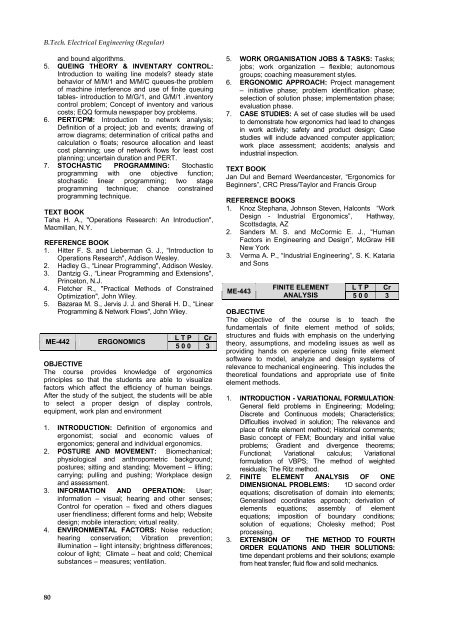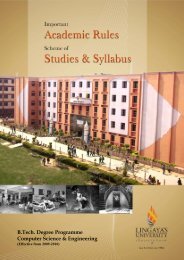B.<strong>Tech</strong>. <strong>Electrical</strong> <strong>Engineering</strong> (Regular)and bound algorithms.5. QUEING THEORY & INVENTARY CONTROL:Introduction to waiting line models? steady statebehavior of M/M/1 and M/M/C queues-the problemof machine interference and use of finite queuingtables- introduction to M/G/1, and G/M/1 .inventorycontrol problem; Concept of inventory and variouscosts; EQQ formula newspaper boy problems.6. PERT/CPM: Introduction to network analysis;Definition of a project; job and events; drawing ofarrow diagrams; determination of critical paths andcalculation o floats; resource allocation and leastcost planning; use of network flows for least costplanning; uncertain duration and PERT.7. STOCHASTIC PROGRAMMING: Stochasticprogramming with one objective function;stochastic linear programming; two stageprogramming technique; chance constrainedprogramming technique.TEXT BOOKTaha H. A., "Operations Research: An Introduction",Macmillan, N.Y.REFERENCE BOOK1. Hitter F. S. and Lieberman G. J., “Introduction toOperations Research", Addison Wesley.2. Hadley G., “Linear Programming", Addison Wesley.3. Dantzig G., “Linear Programming and Extensions",Princeton, N.J.4. Fletcher R., "Practical Methods of ConstrainedOptimization", John Wiley.5. Bazaraa M. S., Jervis J. J. and Sherali H. D., “LinearProgramming & Network Flows", John Wiiey.ME-442ERGONOMICSL T P Cr5 0 0 3OBJECTIVEThe course provides knowledge of ergonomicsprinciples so that the students are able to visualizefactors which affect the efficiency of human beings.After the study of the subject, the students will be ableto select a proper design of display controls,equipment, work plan and environment1. INTRODUCTION: Definition of ergonomics andergonomist; social and economic values ofergonomics; general and individual ergonomics.2. POSTURE AND MOVEMENT: Biomechanical;physiological and anthropometric background;postures; sitting and standing; Movement – lifting;carrying; pulling and pushing; Workplace designand assessment.3. INFORMATION AND OPERATION: User;information – visual; hearing and other senses;Control for operation – fixed and others diaguesuser friendliness; different forms and help; Websitedesign; mobile interaction; virtual reality.4. ENVIRONMENTAL FACTORS: Noise reduction;hearing conservation; Vibration prevention;illumination – light intensity; brightness differences;colour of light; Climate – heat and cold; Chemicalsubstances – measures; ventilation.5. WORK ORGANISATION JOBS & TASKS: Tasks;jobs; work organization – flexible; autonomousgroups; coaching measurement styles.6. ERGONOMIC APPROACH: Project management– initiative phase; problem identification phase;selection of solution phase; implementation phase;evaluation phase.7. CASE STUDIES: A set of case studies will be usedto demonstrate how ergonomics had lead to changesin work activity; safety and product design; Casestudies will include advanced computer application;work place assessment; accidents; analysis andindustrial inspection.TEXT BOOKJan Dul and Bernard Weerdancester, “Ergonomics forBeginners”, CRC Press/Taylor and Francis GroupREFERENCE BOOKS1. Knoz Stephana, Johnson Steven, Halconts “WorkDesign - Industrial Ergonomics”, Hathway,Scottsdagta, AZ2. Sanders M. S. and McCormic E. J., “HumanFactors in <strong>Engineering</strong> and Design”, McGraw HillNew York3. Verma A. P., “Industrial <strong>Engineering</strong>”, S. K. Katariaand SonsME-443FINITE ELEMENT L T P CrANALYSIS 5 0 0 3OBJECTIVEThe objective of the course is to teach thefundamentals of finite element method of solids;structures and fluids with emphasis on the underlyingtheory, assumptions, and modeling issues as well asproviding hands on experience using finite elementsoftware to model, analyze and design systems ofrelevance to mechanical engineering. This includes thetheoretical foundations and appropriate use of finiteelement methods.1. INTRODUCTION - VARIATIONAL FORMULATION:General field problems in <strong>Engineering</strong>; Modeling;Discrete and Continuous models; Characteristics;Difficulties involved in solution; The relevance andplace of finite element method; Historical comments;Basic concept of FEM; Boundary and initial valueproblems; Gradient and divergence theorems;Functional; Variational calculus; Variationalformulation of VBPS; The method of weightedresiduals; The Ritz method.2. FINITE ELEMENT ANALYSIS OF ONEDIMENSIONAL PROBLEMS: 1D second orderequations; discretisation of domain into elements;Generalised coordinates approach; derivation ofelements equations; assembly of elementequations; imposition of boundary conditions;solution of equations; Cholesky method; Postprocessing.3. EXTENSION OF THE METHOD TO FOURTHORDER EQUATIONS AND THEIR SOLUTIONS:time dependant problems and their solutions; examplefrom heat transfer; fluid flow and solid mechanics.80
Lingaya’s University, Faridabad4. FINITE ELEMENT ANALYSIS OF TWODIMENSIONAL PROBLEMS: Second orderequations involving a scalar; valued function;model equation; Variational formulation – Finiteelement formulation through generalisedcoordinates approach; Triangular elements andquadrilateral elements ; convergence criteria forchosen models; Interpolation functions; Elementsmatrices and vectors; Assembly of elementmatrices; boundary conditions; solutiontechniques.5. ISOPARAMETRIC ELEMENTS ANDFORMULATION: Natural coordinates in 1, 2and 3 dimensions; use of area coordinates fortriangular elements in; 2 dimensional problems;Isoparametric elements in 1, 2 and 3 dimensions;Largrangean and serendipity elements;Formulation of element equations in one and twodimensions ; Numerical integration.6. APPLICATIONS TO FIELD PROBLEMS IN TWODIMENSIONS: Equations of elasticity; planeelasticity problems; axisymmetric problems inelasticity; Bending of elastic plates; Timedependent problems in elasticity; Heat transfer intwo dimensions; Incompressible fluid flow andrelated problems.7. INTRODUCTION TO ADVANCED TOPICS (NOTFOR EXAMINATION PURPOSES; Threedimensional problems; Mixed formulation; use ofsoftware packages.TEXT BOOKReddy J. N., “An Introduction to Finite ElementMethod”, McGraw Hill, Intl Student EditionREFERENCE BOOKS1 Zienkiewitch, "The Finite Element Method; BasicFormulation and Linear Problems", Vol 1, 4thEdition, McGraw Hill2 Desai C. S. and Abel J. F., "Introduction to theFinite Element Method", Affiliated East west Press,19723 Rao S. S., “The Finite Element Method in<strong>Engineering</strong>”, Pergaman Press, 1989ME-461RENEWABLE L T P CrSOURCES OF ENERGY 5 0 0 3OBJECTIVEThis gives the knowledge of estimation; conversion andutilization of non conventional sources of energy. Withthe depletion of fossil fuel sources, the importance ofnon-conventional renewable sources of energy hasgained tremendous importance. This courseintroduces the students to these sources and howthese can be utilized for power production.1. INTRODUCTION: Trends of energy consumption;sources of energy; conventional and Renewable;fossil fuel; availability and limitations; need todevelop new energy sources.2. SOLAR ENERGY: Solar radiation characteristicsand estimation; Solar Collectors; Flat Plate andconcentrating types; Their comparative study;design and material selection; Efficiency; Selectivepaints and surfaces; Heating of air and water forbuilding and other Uses; Thermal storages; SolarPonds; Solar pumps; solar Power; Solar Cookersetc; Direct Conversion of Solar energy to electricityand its various uses; materials; limitations andCosts.3. BIO-CONVERSION: Generation of bio-gas;digesters and their design; selection of material;feed to digester; paralytic gasification; productionof hydrogen; Algae production and their uses.4. WIND ENERGY: Types of rotors; horizontal axisand vertical axis systems; system design and siteselection.5. GEO-THERMAL ENERGY: Sites; potentiality andlimitation; study of different conversion systems.6. TIDAL ENERGY: Sites; potentiality and possibilityof harnessing from site; limitations; Ocean ThermalEnergy: Principle of utilization and its limitations;description of various systems.7. OTHER NON-CONVENTIONAL ENERGYSOURCES: Fluidized bed combustions; heat fromwaste and other sources.TEXT BOOKTiwari G. N. and Ghosal M. K., “Renewable EnergyResources”, Narosa Publishing HouseREFERENCE BOOKS1. Rai G. D., “Solar Energy Utilization”, KhannaPublishers, 19952. Duffie J. A. and Beckman, “Solar Heating and Cooling”3. Wakil M. M, EL, “Power Plant <strong>Tech</strong>nology”,McGraw Hill4. Sharma P. C., “Power Plant <strong>Engineering</strong>”, S. K.Kataria and SonsPH-471NON DESTRUCTIVE L T P CrTESTING TECHNIQUES 5 0 0 3OBJECTIVETo give a general overview of novel non destructivetesting methods, the principles behind them, their uses,the advantages and limitations, both in application anddefect detection capability.1. NON-DESTRUCTIVE TESTING: Non-destructivetesting (NDT): role, components and advantages;common NDT techniques.2. ULTRASONIC TESTING: ultrasonic flawdetection: principle, working and applications,advantages and limitations.3. RADIOGRAPHY: X-ray radiography, Gamma myradiography and Neutron radiography; principle,working and applications, advantages and limitations.4. EDDY CURRENT TESTING: Principle, workingand applications of eddy current testing; probesand sensors; testing procedures, applications,advantages and imitations.5. MAGNETIC TESTING: Magnetic testing: particle,flux leakage testing; magnetization methods;detectables. applications and imitations,6. DYE PENETRANT TESTING: Principle, workingand applications of dye penetrant testing,advantages and limitations.7. VISUAL AND OPTICAL TESTING: Principle, workhgand applications of holography, optical interferencetechniques, advantages and limitations.81
- Page 1 and 2:
B.Tech. Degree ProgrammeElectrical
- Page 5 and 6:
Lingaya’s University, FaridabadAB
- Page 7 and 8:
IMPORTANT ACADEMIC RULESB.Tech. Deg
- Page 9 and 10:
Lingaya’s University, Faridabadac
- Page 11 and 12:
Lingaya’s University, FaridabadSe
- Page 13 and 14:
Lingaya’s University, FaridabadIn
- Page 15 and 16:
CATEGORY-WISE LIST OF COURSESLingay
- Page 17 and 18:
Lingaya’s University, FaridabadSU
- Page 19 and 20:
Lingaya’s University, FaridabadSc
- Page 22 and 23:
B.Tech. Electrical Engineering (Reg
- Page 24 and 25:
B.Tech. Electrical Engineering (Reg
- Page 26 and 27:
B.Tech. Electrical Engineering (Reg
- Page 28 and 29:
B.Tech. Electrical Engineering (Reg
- Page 30 and 31:
B.Tech. Electrical Engineering (Reg
- Page 32 and 33:
B.Tech. Electrical Engineering (Reg
- Page 34 and 35: B.Tech. Electrical Engineering (Reg
- Page 36 and 37: B.Tech. Electrical Engineering (Reg
- Page 38 and 39: B.Tech. Electrical Engineering (Reg
- Page 40 and 41: B.Tech. Electrical Engineering (Reg
- Page 42 and 43: B.Tech. Electrical Engineering (Reg
- Page 44 and 45: B.Tech. Electrical Engineering (Reg
- Page 46 and 47: B.Tech. Electrical Engineering (Reg
- Page 48 and 49: B.Tech. Electrical Engineering (Reg
- Page 50 and 51: B.Tech. Electrical Engineering (Reg
- Page 52 and 53: B.Tech. Electrical Engineering (Reg
- Page 54 and 55: B.Tech. Electrical Engineering (Reg
- Page 56 and 57: B.Tech. Electrical Engineering (Reg
- Page 58 and 59: B.Tech. Electrical Engineering (Reg
- Page 60 and 61: B.Tech. Electrical Engineering (Reg
- Page 62 and 63: B.Tech. Electrical Engineering (Reg
- Page 64 and 65: B.Tech. Electrical Engineering (Reg
- Page 66 and 67: B.Tech. Electrical Engineering (Reg
- Page 68 and 69: B.Tech. Electrical Engineering (Reg
- Page 71 and 72: OPEN ELECTIVELingaya’s University
- Page 73 and 74: Lingaya’s University, Faridabadch
- Page 75 and 76: Lingaya’s University, Faridabad4
- Page 77 and 78: Lingaya’s University, Faridabad6.
- Page 79 and 80: Lingaya’s University, FaridabadEL
- Page 81 and 82: Lingaya’s University, Faridabad5
- Page 83: Lingaya’s University, Faridabador
- Page 87: Lingaya’s University, Faridabad83
















